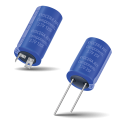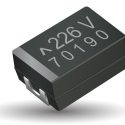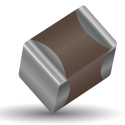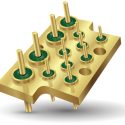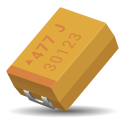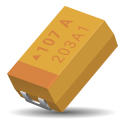Powering IoT Modules Using Solar Panels, SuperCapacitors, and an Automatic Buck/Boost Controller IC Written By: Ron Demcko | Ashley Stanziola | Daniel West Abstract: The use of IoT modules is exhibiting a high rate of growth because of their low cost, ease of implementation, and easily documented impact upon end-user efficiency, reliability, and cost. Manufacturers, installers, and end-users of IoT modules are seeking ways to power these devices and essentially create a set-and-forget module. Set-and-forget means a significant ongoing effort to eliminate batteries or extend the life of batteries powering IoT modules. Manufacturers of IoT modules are working to reduce their designs’ power consumption and also working with IC suppliers by requesting novel chipsets to provide quality power from harvested
Resources
Solid tantalum capacitors have a long history of proven performance in high-reliability military and space applications. But not all capacitors are created equal — even within the same class. As is the case with virtually all component technologies, materials matter. This paper will discuss the differences in performance and reliability between solid tantalum capacitors with manganese dioxide (MnO2) cathodes and those with conductive polymer cathodes. Bell Laboratories introduced the first solid tantalum capacitors to market in the early 1950s. The first military specification for surface-mount tantalum capacitors (MIL-PRF-55365) was released in 1989 and introduced CWR09-style components. Since then, the product offerings governed by this specification have expanded to include CWR19-style capacitors with an extended range of CV values and CWR29-style
AVX MLCC Flexiterm™: Guarding Against Capacitor Crack Failures Written By: Mark Stewart Abstract: The huge popularity of MLCC capacitors in comparison with alternative technologies is primarily a result of their superb reliability record and low cost. However, in certain circumstances problems can occur due to cracking in the ceramic portion of the component. These failures result from mechanical damage caused after soldering to the PCB; normally a consequence of PCB mishandling or when the assembly is located in extreme environmental conditions. This article outlines the main benefits and features of AVX’s ‘FlexiTerm™,’ a soft termination system that minimizes these failures by relieving the mechanical stress applied to the ceramic.
MLCC & TANTALUMINTERCHANGEABILITY Tantalum chip and Hi CV MLCC have a large degree of overlap in available capacitance ratings in common footprints. As MLCC production increased, many applications converted from tantalum to MLCC for many filtering, bypass, and hold-up applications. With the increasing demands seen for low voltage digital applications, tantalum electrolytic technologies have become a first choice for MLCC substitution. KYOCERA AVX is a leading international manufacturer and supplier of a wide range of advanced electronic components, including: capacitors, inductors, filters, and circuit protection devices. The KYOCERA AVX tantalum electrolytic division has maintained a leadership position in automotive, industrial, medical, space, military, consumer electronics, communications, and transportation markets for nearly 50 years. Maximum Available Capacitance by Case Size (6.3V):
EMI Filtering for High-Reliability Applications Amanda Ison KYOCERA AVX Components Corporation Electromagnetic interference (EMI), or electrical noise, is generated by everything from cellphones to solar flares and can make accurate signal transmission as difficult as trying to have a clear conversation in a noisy room. To improve signal clarity in electronic circuits, device designers turn to EMI suppression filters. Effective EMI filtering is necessary for almost every modern electronic device, including devices that generate their own EMI, as well as devices that are sensitive to EMI within their environment, and is especially important in high-reliability applications that utilize lower-power signals and have strict signal fidelity demands. High-reliability EMI filters are designed to consistently meet or exceed performance requirements and are
Temperature Stability Assessment of GaN Power Amplifiers with Matching Tantalum Capacitors Written By: Ron Demcko | Mitch Weaver | Daniel West Abstract: Wide band gap GaN and SiC devices are expected to experience high levels of growth in applications ranging from power conversion to RF transistors and MMICs. End users recognize the advantages of GaN technology as an ability to operate under higher currents and voltages. RF GaN market is expected to grow at 22.9 % CAGR over 2017-2023, boosted by implementation of 5G networks. [1] During the past years, the wide band semiconductors have reported achievement of >1000 V BDV that opens new challenges for high power industrial applications such as electric traction systems in trams, trolley buses or
High-Reliability Solid Tantalum Capacitors Bob Fairey AVX Corporation, One AVX Blvd, Fountain Inn, SC 29644www.avx.com Solid tantalum capacitors are among the most popular types of small, surface-mount capacitors for electronic applications across the consumer, automotive, aerospace, and medical device markets. This paper will provide some context on the development of tantalum capacitor technology and address issues frequently faced by users, including the need for low equivalent series resistance (ESR) in filtering applications and the need for the highest possible reliability and long-lifetime performance in aerospace and medical applications. Figure 2: The dielectric surface area of a tantalum capacitor anode compared to its finished size. Over the course of the following decades, tantalum capacitor technology evolved to include several form factors.
Voltage Derating Rules for Solid Tantalum and Niobium Capacitors Written By: Tomáš Zedníček | John Gill Abstract: For many years, whenever people have asked tantalum capacitor manufacturers for general recommendations on using their product, the consensus was “a minimum of 50% voltage derating should be applied”. This rule of thumb has since become the most prevalent design guideline for tantalum technology. This paper revisits this statement and explains, given an understanding of the application, why this is not necessarily the case. With the recent introduction of niobium and niobium oxide capacitor technologies, the derating discussion has been extended to these capacitor families also.
Ultrathin Discrete Capacitors for Emerging Embedded Technology Written By: Radim Uher | Tomas Zednicek Abstract: Passive components can represent as much as 70% of PCB footprint in today’s electronic systems. The development of a suitable technology whereby integrated passive components are embedded into the PCB body has been one of the key trends in downsizing for more than a decade. Latest achievements have allowed the implementation of this ‘embedding technology’ into pre-production and even mass production. The next step requires the involvement of the complete supply chain, including traditional passive component manufacturers. This paper will present the state of the art in the development of ultrathin discrete capacitor technology and discuss the challenges of overcoming mechanical, electrical and thermo-mechanical issues
Thermal Management of Surface Mounted Tantalum Capacitors Written By: Ian Salisbury Abstract: This paper covers thermal management of surface mounted tantalum capacitors, and explores the thermal characteristics and how these are modified by the thermal interconnection substrate. The paper explores the different methods of mounting to reduce the thermal resistance to the PCB, also the affect of the design of connection pads on the PCB to reduce the thermal stress on the capacitor.
Thermal and Electrical Breakdown Versus Reliability of Ta2O5 under Both – Bipolar Biasing Conditions
Thermal and Electrical Breakdown Versus Reliability of Ta2O5 under Both – Bipolar Biasing Conditions Written By: P. Vašina | T. Zedníček | Z. Sita | J. Sikula | J. Pavelka Abstract: Our investigation of breakdown is mainly oriented to find a basic parameters describing the phenomena as well as its impact on reliability and quality of the final product that is “GOOD” tantalum capacitor. Basically, breakdown can be produced by a number of successive processes: thermal breakdown because of increasing conductance by Joule heating, avalanche and field emission break, an electromechanical collapse due to the attractive forces between electrodes electrochemical deterioration, dendrite formation and so on. Breakdown causes destruction in the insulator and across the electrodes mainly by melting and
Tantalum Capacitors Technology for Extended Operating Temperature Range Written By: T.Zedníček | Z.Sita | S.Pala Abstract: New materials, capable to operate at higher temperatures, new techniques of their processing and new procedures for increasing the stability have been implemented to AVX THJ series to extend the continuous operating temperature up to 175°C while maintaining twice better reliability specification compare to the standard range of tantalum capacitors.
Tantalum and Oxicap® Niobium Oxide Capacitors Deliver Enhanced Reliability, Wide Temperature Range & Low Leakage for Automotive Applications Written By: R. Faltus Abstract: In nowadays modern cars we can find many electronic systems controling engine, gear box, caring for passenger comfort, assuring safety and security, etc. Automotive applications are specific by their harsh electrical and environmental conditions together with requirements for high overall reliability and lifetime. Any electronic part used in such system play important role to assure reliability and functionality. Different capacitor technologies –tantalum, MLCC, NbO, aluminium are available but some of them meet the specific requirements better than others.
Tantalum and Niobium Technology Roadmap Written By: T. Zednicek | B. Vrana | W. A. Millman | J. Gill | Chris Reynolds Abstract: This paper presents an overview of the key features of emerging capacitor technologies – tantalum, niobium metal and niobium oxide in order to give designers a better understanding of the potential applications and to guide their choice of component solutions for their individual requirements. The second part of the paper is targeted to a new type of solid electrolyte capacitor that has been developed based on niobium oxide powder material. Capacitors made from niobium oxide powder offer the designer many interesting features such as significantly reduced ignition failure mode, better load resistance, reduced cost, etc. The paper
TA Capacitors With Conductive Polymer Robust to Lead Free Process Written By: Z. Sita | M. Biler Abstract: Tantalum capacitors with conductive polymer cathodes have found a place in the market as a low ESR component with reduced ignition. Conductive polymer cathodes however, suffer from instability during multiple high temperature thermal treatments such as lead free soldering due to its limited self healing ability and lower thermal and mechanical strength compared with manganese dioxide. This makes capacitors with conductive polymer cathode more sensitive to thermo-mechanical stresses, which appear during soldering and to negative influences of storage condition after removal from the protective packaging prior to soldering. This paper describes methods of improving the robustness of such capacitors with lead free
Storage Capacitor Properties and Their Effect on Energy Harvester Performance Written By: Radovan Faltus | Miroslav Jáně | Tomáš Zedníček Abstract: The development of energy harvesters has quickened up in the last few years mainly due to semiconductor improvements. But power sources for energy harvesters usually exhibit high internal impedance and can therefore only deliver low currents. The most important consideration for harvesting is that the power consumption of the controller circuitry must be less than the energy generated by the power source. Energy harvesters use a storage capacitor slowly charged from power source through the controller and the leakage current of this capacitor is wastes a certain percentage of the generated energy. This paper will evaluate this effects of
